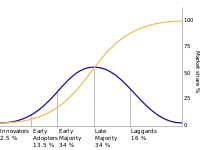
Photo from wikipedia
OBJECTIVE The objective of this study was to characterize the diffusion of methodological innovation. STUDY DESIGN AND SETTING Comparative case study analysis of the diffusion of two methods that summarize… Click to show full abstract
OBJECTIVE The objective of this study was to characterize the diffusion of methodological innovation. STUDY DESIGN AND SETTING Comparative case study analysis of the diffusion of two methods that summarize confounder information into a single score: disease risk score (DRS) and high-dimensional propensity score (hdPS). We completed systematic searches to identify DRS and hdPS papers in the field of pharmacoepidemiology through to the end of 2013, plotted the number of papers and unique authors over time, and created sociograms and animations to visualize co-authorship networks. First and last author affiliations were used to ascribe institutional contributions to each paper and network. RESULTS We identified 43 DRS papers by 153 authors since 1981, reflecting slow uptake during initial periods of uncertainty and broader diffusion since 2001 linked to early adopters from Vanderbilt. We identified 44 hdPS papers by 147 authors since 2009, reflecting rapid and integrated diffusion, likely facilitated by opinion leaders, early presentation at conferences, easily accessible statistical code, and improvement in funding. Most contributions (87% DRS, 96% hdPS) were from North America. CONCLUSION When proposing new methods, authors are encouraged to consider innovation attributes and early evaluation to improve knowledge translation of their innovations for integration into practice, and we provide recommendations for consideration.
Journal Title: Journal of clinical epidemiology
Year Published: 2017
Link to full text (if available)
Share on Social Media: Sign Up to like & get
recommendations!